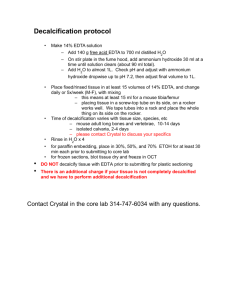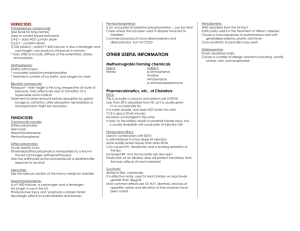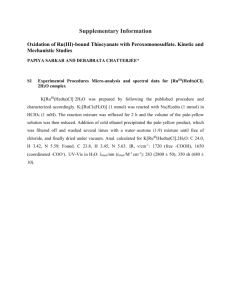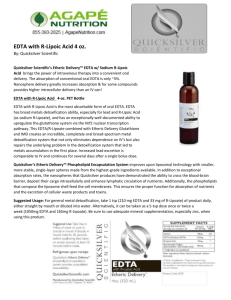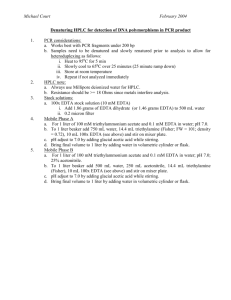Use of Chelating Agent EDTA with Sodium Thiosulphate and
advertisement
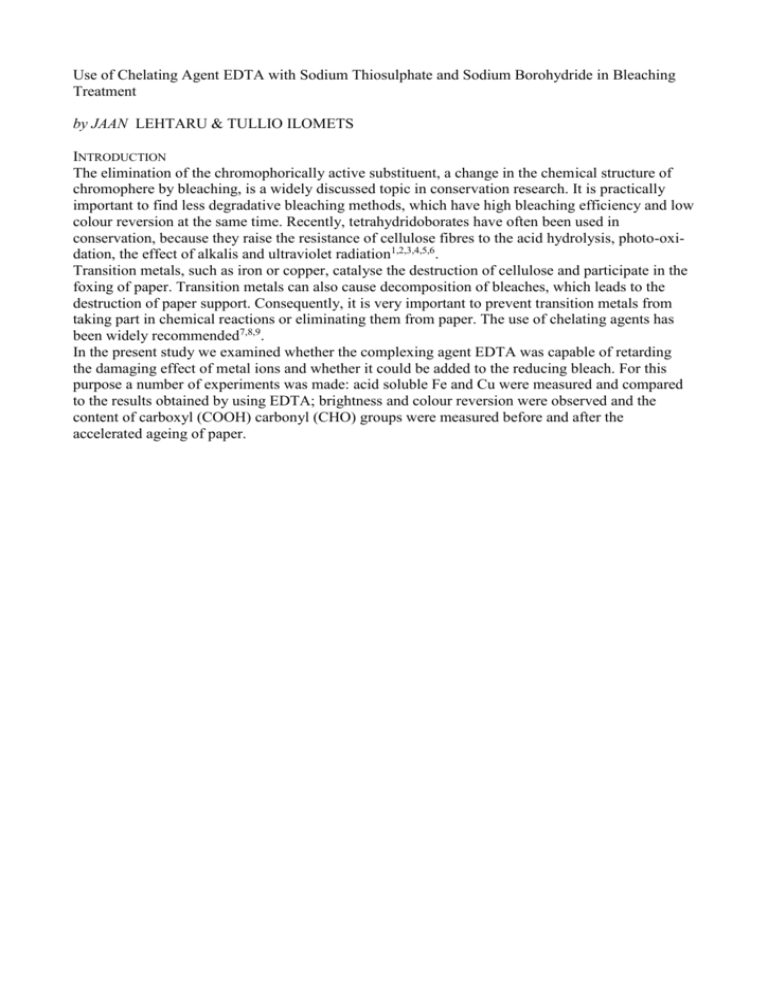
Use of Chelating Agent EDTA with Sodium Thiosulphate and Sodium Borohydride in Bleaching Treatment by JAAN LEHTARU & TULLIO ILOMETS INTRODUCTION The elimination of the chromophorically active substituent, a change in the chemical structure of chromophere by bleaching, is a widely discussed topic in conservation research. It is practically important to find less degradative bleaching methods, which have high bleaching efficiency and low colour reversion at the same time. Recently, tetrahydridoborates have often been used in conservation, because they raise the resistance of cellulose fibres to the acid hydrolysis, photo-oxidation, the effect of alkalis and ultraviolet radiation1,2,3,4,5,6. Transition metals, such as iron or copper, catalyse the destruction of cellulose and participate in the foxing of paper. Transition metals can also cause decomposition of bleaches, which leads to the destruction of paper support. Consequently, it is very important to prevent transition metals from taking part in chemical reactions or eliminating them from paper. The use of chelating agents has been widely recommended7,8,9. In the present study we examined whether the complexing agent EDTA was capable of retarding the damaging effect of metal ions and whether it could be added to the reducing bleach. For this purpose a number of experiments was made: acid soluble Fe and Cu were measured and compared to the results obtained by using EDTA; brightness and colour reversion were observed and the content of carboxyl (COOH) carbonyl (CHO) groups were measured before and after the accelerated ageing of paper. MATERIALS AND METHODS Test paper A rag paper: moisture content 3.62%, ash content 1.16%, content of extractives 0.01%. 19th century rag paper was manufactured in Russia and used for printing in Moscow (1832). Bleach solutions Seven different bleach solutions were used: The procedures were carried out at room temperature (22°C) with less than 3°C variation among various treatments. Distilled water was used in preparation of all of the solutions. The pH was checked and adjusted to 5.0 and 9.5 with acetic acid or sodium hydroxide. Paper samples were bleached for four different times (2, 6, 14 and 26 min), using the same NaBH1 solution. Borohydride solutions were not used immediately but allowed to equilibrate (by self buffering) 30 min, until hydrogen evolution had slowed down. After bleaching the samples were transferred to three different washing trays (with 1.5 1 of distilled water) and washed for 10 min to remove residual chemicals. Paper was dried between acid-free blotters and after approximately 18 hours the reflectance was measured. Brightness measuring was carried out using spectrophotometer fitted with an integrated sphere reflectance attachment using barium sulphate as a reference standard. The usual wavelength for the detection of yellowing of paper 457 nm was chosen. Degradative effect was characterized by measuring carbonyl (CHO) and car-boxyl (COOH) groups on paper. The content of aldehyde groups was determined by Copper Number (TAPPI Standard T 430) and the content of carboxyl groups by calcium acetate10. The accelerated ageing of paper was carried out during 28 days in darkness at 75°C and 40% of RH. After accelerated ageing brightness, the content of CHO and COOH groups were measured. For the determination of iron and copper in paper a flame atomic absorption spectrometer (VARIAN Spectr AA 250 Plus) was used. Paper extracts were obtained by acid destruction according to SFS 3047 (Finnish Standard) and after treatment with Na2S2O3/EDTA. Na2S2O3/EDTA method A weighed sample of paper was placed in a 250 ml flask. 2% Na2S2O2 • 5H2O (50 ml) and 0.1 M EDTA (50 ml) was added. The sample was held in this solution for 14 min and then shaken for 3 min (22°C). pH was adjusted to 5 and 9.5 because ferric ions form the most stable complexes with EDTA at pH values from 4 to around 7 and copper around pH 8 to 11. The mixture was filtered and washed using two portions (50 ml each) of water and filtrate transferred to a 200 ml volumetric flask. For measuring Fe and Cu content with flame atomic absorption spectrometer 5 ml was taken. The content of iron and copper The average values of four measurements are presented in Table 1. The iron content in paper extracts after treatment with 2% Na2S2O3 • 5H2O / 0.1 M EDTA (pH 5.0) makes ~1/3 of acid soluble iron content. The difference between copper content values is not considerable. It shows that EDTA works quite effectively. Table 1. Iron and copper RESULTS AND DISCUSSION Brightness values after bleaching The datapoints for the average value for unbleached and aged samples are shown. The brightness of rag paper increases after washing from 81.07% to 88.68% (8.58% increase in brightness value compared to the initial value). The bleach solutions may be listed in the following order of increase in brightness (Table 2, Fig. 1). Fig. 1: Brightness of bleached samples (U = unbleached) Fig. 2: Brightness of bleached paper after accelerated ageing (28 days) The rate of colour reversion can be correlated to the total brightness change. Samples of paper treated with sodium borohydride solutions have a higher bleaching stability than those treated with sodium thiosulphate solutions. EDTA has no effect on the colour stability of paper treated with NaBH4, but adding chelating agent to the Na2S2O3 solutions seems useful (Table 3, Fig. 1 and 2). The washing procedure is very important, because washed unbleached paper shows a good brightness level after ageing when compared to an unwashed sample. All bleached samples have a higher brightness level after accelerated ageing than the unbleached sample before ageing (Table 4, Fig. 1 and 2). Table 2: Results of measurements of brightness after 14 min of bleaching Table 3: Results of measurements of brightness after accelerated ageing (28 days) Table 4: Brightness, content of COOH and CHO groups Fig. 3: Changes of COOH groups of paper after bleaching (U = untreated) Fig. 4: Changes of COOH groups of bleached paper after accelerated ageing (28 days) Changes in the content of carboxyl and carbonyl groups Changes in the content of carboxyl groups using reducing bleaches are not remarkable. All bleach solutions (except solutions E and G) indicate a slight tendency to decrease in carboxyl groups after bleaching. The content of COOH groups in bleached samples after accelerated ageing is comparable to unbleached paper (Table 4, Fig. 3 and 4). Fig. 5: Changes of CHO groups of paper after bleaching (U = untreated) Fig. 6: Changes of CHO groups of bleached paper after accelerated ageing (28 days) The biggest decrease in CHO groups was obtained by using bleach solution G (Fig. 5). It seems that the correlation to a certain extent between the content of CHO groups (which are responsible for yellowing) and brightness value does exist (Table 2, 3 and 4). Papers treated with bleach solutions A, F and G have a smaller content of CHO groups after accelerated ageing than unbleached paper (Table 4, Fig. 5 and 6). CONCLUSIONS • Chelating agent EDTA can be shown to be useful in the removal of iron and copper on cellulose fibres. The best approach to the removal of stains caused by iron and copper is the use of a reducing agent coupled with a chelating agent. • EDTA improves the colour stability of papers treated with sodium thiosulphate, but does not benefit to the colour stability of paper treated with NaBH4. • Supposedly, Fe and Cu ions, which remained in paper, were released from the complexes by chelating agent, they can be oxidized and the preliminary effect of EDTA is lessening in the course of time. • Despite of the lower content of CHO groups after bleaching, the paper samples treated with EDTA indicate the tendency of CHO content to increase after accelerated ageing. • It is necessary to introduce Mg and Ca ions back into the paper after treatment with EDTA. • The use of EDTA in practical conservation is limited owing to it stimulating the adverse effect of ink corrosion. • The mechanism of all reactions which take place in paper when EDTA is used as a chelating agent are still not clear and need more detailed investigations. ACKNOWLEDGEMENT The authors appreciate the help of M. Tars and A. Kasikov from the Institute of Physics, Tartu, for providing spectrophotometer. SUMMARIES Use of chelating agent EDTA with sodium thiosulphate and sodium borohydride in bleaching treatment This article briefly reviews the use of chelating agent EDTA with sodium thiosulphate and sodium borohydride in bleaching treatment. A rag paper (1832) was chosen for experiments. Acid soluble iron and copper were measured and compared to the results obtained by using EDTA. Brightness and colour reversion were observed and the content of COOH and CHO groups were measured before and after the accelerated ageing of paper. It is shown that the chelating agent can be useful in the removal of iron and copper on cellulose fibres. The best approach seems to be the use of a reducing agent coupled with a chelating" agent. If sodium thiosulphate is used the colour stability of the treated paper is improved, but this is not the case with NaBH4. Altogether, the mechanisms of all reactions which take place in paper when EDTA is used are still not clear and need more detailed investigations. Utilisation de I'agent chelateur EDTA au thiosulfate de sodium et au borohydrure de sodium lors du blanchiment du papier L'article decrit brievement l'utilisation de I'agent chelateur EDTA au thiosulfate de sodium et au borohydrure de sodium dans la procedure de blanchiment du papier. Le papier retenu pour nos analyses est du papier chiffon datant de 1832. Les mesures suivantes ont ete effectuees: teneur en fer et en cuivre par la methode acide, blancheur et stabilite de la blancheur, teneur des groupes COOH- et CHO avant et apres le vieillissement accelere. On demontre quo Pagent chelateur pent etre utile pour eliminer le fer et lc cuivre des fibres de cellulose. La meilleure approche semble consister en l'utilisation d'un agent reducteur couple avec un agent chelateur. Les resullats des recherches ont demontre que l'utilisation des agents chelatiques (EDTA) avec I'agent reducteur est efficace pour la separation du fer et du cuivre du papier. Avec l'utilisation du thiosulfate de sodium, la stabilite de blancheur des papier s'est amelioree, sauf pour le papier traite par NaBH4. En general, le mechanisme des reactions en presence de EDTA n'est pas suffisamment clair et demande de recherches supplementaires dans l'avenir. Die Anwendung der Komplexverbindung EDTA beim Bleichen znsammen mil Natrium-thiosulfat und Natriumborhydrid Der Artikel gibt einen Überblick über die Anwendung der Komplexverbindung EDTA beim Bleichen zusammen mit Natriumthiosulfat und Natriumborhydrid. Für die Untersuchung wurde Hadernpapier eines Buches aus dem Jahre 1832 verwendet. Es wurden folgende Messungen durchgeführt: Säurelösliches Eisen und Kupfer, Weißgrad und Farbstabilität, Gehalt von COOHund CHO-Gruppen vor und nach der künstlichen Alterung. Es wird gezeigt, daß der Chelat-bildner nützlich sein kann zum Entfernen von Eisen und Kupfer aus Cellulosefasern. Die beste Wirkung scheint die Kombination eins Reduktionsmittel mit dem Chelatbildner zu sein. Hierbei verbessert Natriumthiosulfat die Farbstabilität des behandelten Papiers, nicht aber Natriumborhydrid. Insgesamt sind die Ablaufmechanismen und die Reaktionen, die beim Einsatz von EDTA stattfinden, nicht völlig klar und bedürfen weiterführender Forschung. REFERENCES 1. Durovic, M.&J. Zelinger: Chemical processes in the bleaching of paper in library and archival collections. Restaurator 14 (1993): 78-101. 2. Burgess, H.: Practical considerations far conservation bleaching.]. IIC-CG 13 (1988): 11-26. 3. Hey, M.: Paper bleaching: It's simple chemistry and working procedures. Paper Conservator 4 (1979): 10-23. 4. Burgess, H.: The colour reversion of paper after bleaching. Conservation of Library and Archives Materials and the Graphic Arts. G. Petherbridge, ed., London: Butterworth 1987: 328. 5. Lienardy, A., & P. Van Damme: A bibliographical survey of the bleaching of paper. Restaurator 9 (1988): 178-198. 6. Sobucki, W.: Borhydride - wertvolle Millel zur Restaurierung von Papier. Restauro 1993: 260263. 7. Cotton, F. A., & G. Wilkinson: Advanced inorganic chemistry. Xxx: Wiley 1988: 14.55. 8. Kask, U. &J.D. Rawn: General chemistry. Xxx: WCB Communications 1993: 988. 9. Salomons, W., U. Förstner & P. Mader: Heavy metals. Heidelberg: Springer 1995: 412. 10. Lehtaru,J.: Changes of content of carboxyl groups on different kinds of paper during accelerated ageing. Acta et Commentationes Universitatis Tartuensis 966. Publications on Chemistry XXI. Tartu 1993: 197-210. Jaan Lehtaru Tartu University Library 1 W. Struve St. Tartu EE2400 Estonia Tullio Hornets Institute of Organic Chemistry, University of Tartu 2Jakobi St. Tartu EE2400 Estonia



